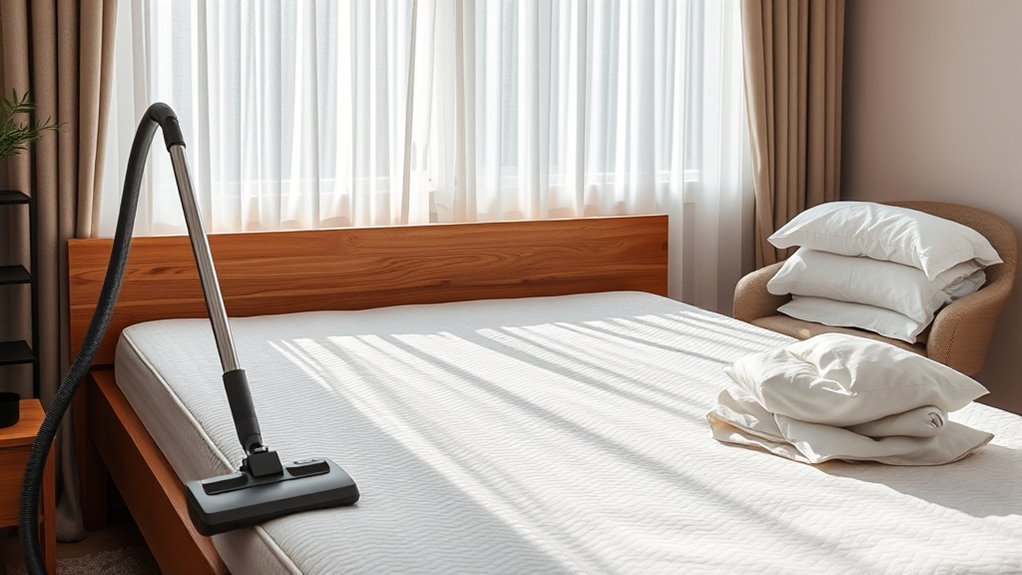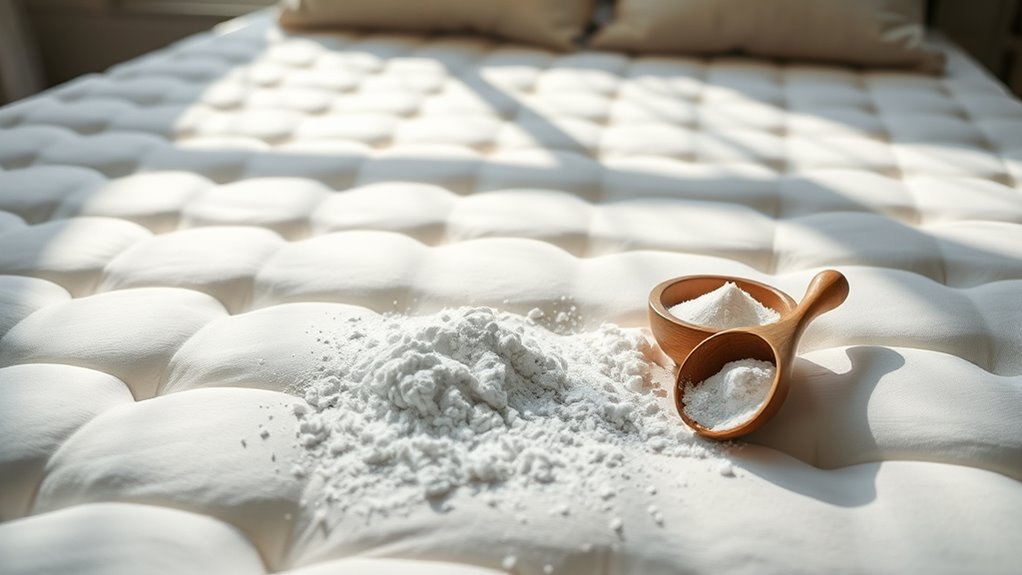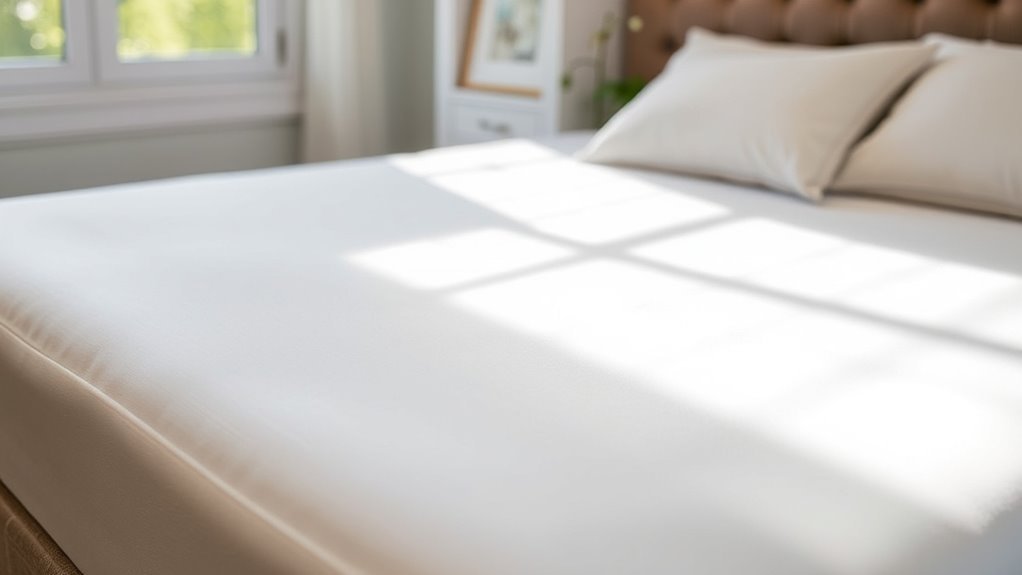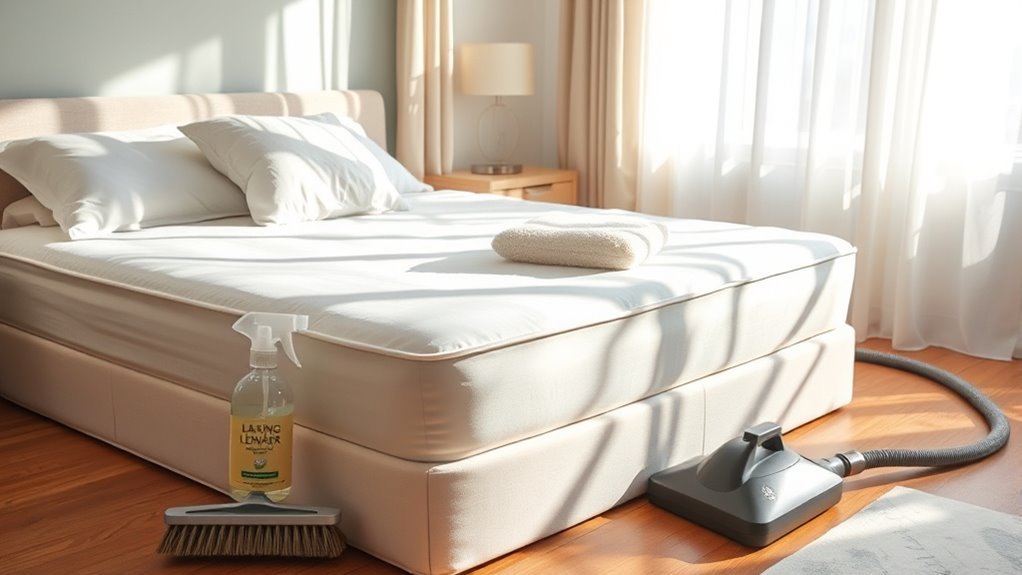Top 10 Tips for Cleaning Mattress
Start by stripping your bedding and vacuuming the mattress thoroughly. Spot clean stains immediately with mild detergent or natural solutions like baking soda and diluted vinegar. Sprinkle baking soda for deodorizing and air out your mattress regularly to reduce moisture. Use hypoallergenic sprays to combat allergens and avoid harsh chemicals that can damage fabric. Protect your mattress with a cover and consider professional cleaning every 12-18 months. Keep following to uncover more helpful mattress care tips.
Remove Bedding and Vacuum Thoroughly

Start by stripping off all the bedding, including sheets, pillowcases, and mattress protectors. This simple step is essential for proper mattress care and gives you the freedom to start fresh. Once the bed is bare, grab your cleaning tools—a vacuum with a hose attachment works best. Thoroughly vacuum the entire mattress surface, focusing on seams and crevices where dust and debris gather. This removes allergens and dust mites, letting your mattress breathe and stay healthy. Don’t rush this process; a deep vacuum guarantees you’re not just masking dirt but eliminating it. Taking these steps regularly empowers you to maintain a cleaner, more comfortable sleeping space without hassle. It’s the foundation of mattress care that keeps you feeling free and refreshed every night.
Spot Clean Stains Immediately
After you’ve thoroughly vacuumed your mattress, it’s important to address any stains as soon as they appear. Prompt stain removal keeps your mattress fresh and prevents permanent damage. Here are some effective cleaning techniques you can use:
Address stains promptly after vacuuming to keep your mattress fresh and prevent lasting damage.
- Blot the stain gently with a clean cloth to absorb excess liquid—avoid rubbing.
- Use a mild detergent mixed with water for organic stains like sweat or food.
- Apply a mixture of hydrogen peroxide and baking soda for tougher stains, testing a small area first.
- Avoid soaking the mattress; use minimal moisture to prevent mold growth.
Use Baking Soda to Deodorize

Though you can’t see odors, they can linger in your mattress and affect your sleep quality. Using baking soda to deodorize is a simple, natural way to refresh your sleeping space. It neutralizes smells without harsh chemicals, offering many baking soda benefits that align with your desire for a clean, toxin-free environment.
| Step | What You Need | Tip |
|---|---|---|
| Sprinkle generously | Baking soda | Cover entire mattress surface |
| Let it sit | 30 minutes to 24 hours | Longer for stronger odors |
| Vacuum thoroughly | Vacuum cleaner | Remove all baking soda |
| Repeat monthly | Baking soda | Maintain freshness |
These deodorizing techniques free you from stale smells, improving your comfort and sleep quality naturally.
Apply a Mild Detergent Solution for Deep Cleaning
When you want to tackle deeper stains and dirt, applying a mild detergent solution can refresh your mattress effectively without causing damage. Choosing the right detergent types and cleaning methods is key to preserving your mattress’s integrity while freeing it from grime. Here’s how to do it:
Use a mild detergent and gentle cleaning to refresh your mattress without risking damage or moisture buildup.
- Mix a small amount of mild detergent with warm water.
- Use a clean cloth or sponge to gently blot the solution onto stained areas.
- Avoid soaking the mattress; excess moisture can lead to mold.
- Let the mattress air dry completely before making the bed.
This approach allows you to deep clean confidently and maintain a fresh sleeping surface. Remember, gentle detergent types and careful cleaning methods keep your mattress clean without sacrificing its durability or your freedom to relax.
Use a Mattress Protector to Prevent Future Stains

Once you’ve cleaned your mattress thoroughly, protecting it from future stains is the smartest next step. Using a mattress protector gives you freedom from worrying about spills, sweat, or allergens compromising your mattress hygiene. These protectors act as a barrier, preventing stains from settling deep into the fabric and making future cleanings easier. Plus, they help maintain the mattress’s freshness and longevity. Choose a waterproof, breathable protector that fits snugly to keep dust mites and bacteria at bay without sacrificing comfort. Investing in this simple layer means you’re actively practicing stain prevention, ensuring your mattress stays clean and inviting. It’s a small effort that pays off big by preserving your sleep environment and giving you peace of mind every night.
Rotate and Flip Your Mattress Regularly
To keep your mattress wearing evenly, you should rotate and flip it regularly. This simple habit helps prevent sagging in one spot and keeps your mattress feeling comfortable longer. By doing this, you’ll also extend the overall lifespan of your mattress.
Prevent Uneven Wear
Although it might seem simple, rotating and flipping your mattress regularly is key to preventing uneven wear. By practicing proper mattress rotation, you avoid developing permanent wear patterns that can make your bed uncomfortable. Taking a few minutes every few months guarantees your mattress stays supportive and comfy. Here’s how to keep uneven wear at bay:
- Rotate your mattress 180 degrees head to foot every 3-6 months.
- Flip the mattress over if it’s double-sided.
- Watch for sagging or lumps indicating uneven wear.
- Use a mattress protector to reduce surface wear.
Staying on top of these steps means your mattress will feel fresh and balanced, giving you freedom from discomfort and the best sleep experience possible.
Extend Mattress Lifespan
Regularly rotating and flipping your mattress is one of the simplest ways to extend its lifespan. By doing this, you prevent uneven wear and make the most of your mattress materials. It’s a freeing habit that pairs well with smart cleaning techniques—keeping your sleep space fresh and durable. Here’s a quick guide to help you remember when and why:
| Action | Benefit | Frequency |
|---|---|---|
| Rotate 180° | Even wear distribution | Every 3 months |
| Flip mattress | Balanced pressure | Every 6 months |
| Vacuum surface | Remove dust & mites | Monthly |
| Spot clean | Target stains | As needed |
| Air out mattress | Reduce moisture | Monthly |
Stick to this routine and enjoy a mattress that feels like new, giving you the freedom to rest easy longer.
Air Out Your Mattress to Reduce Moisture
When you air out your mattress, you help prevent moisture buildup that can lead to mold and odors. Mattress moisture collects silently, but with proper air circulation, you can keep your sleeping space fresh and free. Here’s how to let your mattress breathe and reclaim your freedom from dampness:
Airing out your mattress prevents moisture buildup, keeping your sleeping space fresh and free from mold and odors.
- Strip all bedding and let the mattress sit uncovered for several hours.
- Open windows or doors to promote natural air flow around your bed.
- Use a fan to boost air circulation on humid days or in enclosed rooms.
- Regularly rotate or flip your mattress to expose all sides to fresh air.
Treat Allergens With Hypoallergenic Sprays
Since allergens can easily settle into your mattress fibers, treating it with hypoallergenic sprays is a smart way to reduce irritants like dust mites and pet dander. These sprays offer effective allergen reduction without introducing harsh chemicals, helping you breathe easier and enjoy a cleaner sleeping space. You’ll appreciate the hypoallergenic benefits, especially if you’re sensitive to common allergens or want to maintain a fresh, healthy mattress environment. Simply spray lightly and allow it to dry completely before making your bed. This simple step empowers you to take control of your mattress cleanliness and overall well-being, giving you freedom from sneezing and discomfort. Regular use keeps your mattress inviting and safer for restful nights, all while supporting your allergy management efforts.
Avoid Harsh Chemicals for Mattress Cleaning
Although it might seem easier to reach for strong cleaning agents, you should avoid using harsh chemicals on your mattress. These substances can damage the fabric, reduce its lifespan, and release harmful fumes that restrict your freedom to breathe easy. Instead, opt for natural alternatives that are safe and effective. You can make your own gentle cleaning solutions at home, ensuring your mattress stays fresh without compromise.
Consider these tips:
- Use a mix of baking soda and essential oils to deodorize.
- Try diluted white vinegar for spot cleaning stains.
- Employ mild soap with warm water for surface dirt.
- Let your mattress air dry completely to prevent mold.
Choosing these natural alternatives helps you maintain a clean, healthy sleeping space without harsh chemicals holding you back.
Schedule Professional Mattress Cleaning Periodically
You’ll want to schedule professional mattress cleaning every 12 to 18 months to keep it fresh and allergen-free. Experts use specialized equipment that removes deep dirt and dust mites better than regular cleaning. When choosing a service, look for certified cleaners with good reviews to guarantee quality care.
Benefits of Professional Cleaning
When you schedule professional mattress cleaning periodically, you guarantee a deeper, more thorough cleanse than regular home methods can provide. This expert approach uses advanced cleaning techniques that not only refresh your mattress but also extend its lifespan. You’ll enjoy benefits that free you from constant worry about allergens and stains.
- Enhances mattress longevity by removing embedded dirt and dust mites
- Utilizes powerful, safe cleaning techniques for a hygienic sleep environment
- Eliminates stubborn stains and odors that DIY methods often miss
- Saves you time and effort, letting you focus on what matters most
Recommended Cleaning Frequency
Scheduling professional mattress cleaning at least twice a year helps keep your sleep environment fresh and healthy. Sticking to a consistent cleaning schedule prevents allergens, dust mites, and stains from building up, giving you more freedom to enjoy restful sleep without worries. Along with routine vacuuming and spot cleaning, incorporating professional services into your maintenance tips guarantees deep cleaning you can’t achieve alone. Remember, your mattress works hard for you every night, so regular care preserves its comfort and lifespan. By setting reminders for these biannual cleanings, you create a hassle-free routine that supports both hygiene and relaxation. Embrace this simple habit, and your mattress will stay in great shape, letting you rest easy and fully enjoy your freedom.
Choosing a Cleaning Service
How do you find the right professional mattress cleaning service? Start by focusing on what truly matters to you—quality and freedom from hassle. Check service reviews to see real experiences from other customers. Understanding their cleaning methods helps you pick a service that aligns with your preferences, whether eco-friendly or deep sanitizing. Here’s a quick guide:
- Research different companies’ cleaning methods for effectiveness and safety.
- Read service reviews to gauge reliability and customer satisfaction.
- Confirm the service offers flexible scheduling to fit your lifestyle.
- Ask about guarantees or follow-up services to guarantee lasting cleanliness.
Frequently Asked Questions
How Often Should I Replace My Mattress for Optimal Hygiene?
You should aim to replace your mattress every 7 to 10 years to maintain ideal hygiene standards. Over time, mattresses lose support and accumulate allergens, dust mites, and sweat, which can affect your health. Sticking to the mattress lifespan helps you enjoy better sleep quality and freedom from discomfort or allergies. If you notice sagging or increased allergies sooner, it might be time to upgrade earlier for a fresher, cleaner sleep environment.
Can Mattress Cleaning Help Reduce Dust Mite Allergies?
Yes, mattress cleaning can definitely help reduce dust mite allergies. When you regularly clean your mattress, you’re actively practicing dust mite prevention, which cuts down the allergens that trigger your allergy symptoms. By keeping your sleeping area fresh and free from dust mites, you’ll breathe easier and enjoy better rest. So, taking this simple step gives you the freedom to wake up feeling refreshed, not congested or itchy.
What Materials Are Best for Hypoallergenic Mattresses?
When choosing hypoallergenic mattresses, you’ll want to contemplate memory foam and latex materials. Both are naturally resistant to dust mites and allergens, giving you a cleaner sleeping environment. Memory foam contours to your body, offering support and comfort, while latex materials are breathable, keeping things fresh. If you’re after freedom from allergies and better sleep, these options are great because they reduce irritants and promote a healthier rest without extra hassle.
How Do Mattress Thickness and Firmness Affect Cleaning Methods?
When it comes to mattress thickness and firmness, you’ll find they impact your mattress maintenance and cleaning techniques. Thicker, firmer mattresses can be harder to maneuver, so spot cleaning might be easier than deep cleaning. Softer, thinner mattresses may absorb stains quicker, requiring gentler cleaning methods to avoid damage. Knowing this helps you choose the right approach, giving you the freedom to keep your mattress fresh without hassle or risk.
Are There Eco-Friendly Mattress Cleaning Products Available?
Yes, you can definitely find eco-friendly solutions for cleaning your mattress. Natural alternatives like baking soda, white vinegar, and essential oils work wonders without harsh chemicals. These products let you keep your sleeping space fresh while staying kind to the planet. You don’t have to sacrifice your freedom to choose effective cleaning methods that align with your values—just embrace these green options and enjoy a healthier, cleaner mattress naturally.






